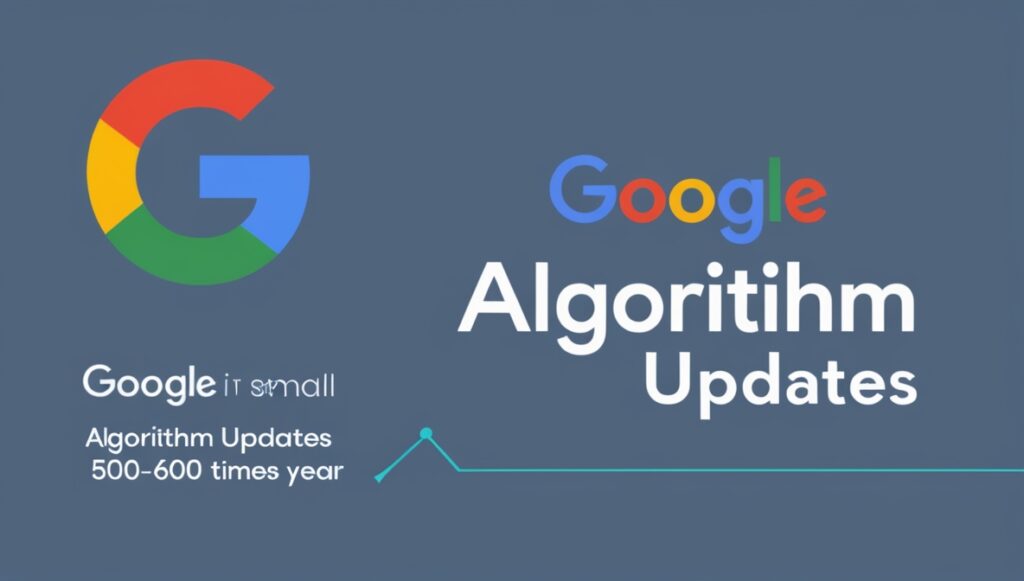
In the world of digital marketing, staying ahead of Google’s frequent algorithm updates is vital for maintaining a competitive edge in search engine optimization (SEO). Google’s algorithms play a significant role in determining how websites rank on search engine results pages (SERPs). For businesses aiming to optimize their online presence, understanding the nuances of “Google update frequency SEO” is crucial.
In this article, we’ll dive into how often Google updates its algorithms, the impact of these changes on SEO, and actionable strategies to adapt to this dynamic environment.
How Often Does Google Update Its Algorithm?

A common question among SEO professionals and digital marketers is, “How often does Google update its algorithm?” Experts estimate that Google updates its algorithm somewhere between 500-600 times per year. Most of these updates are minor and go unnoticed, but occasionally, Google introduces major updates like BERT or Passage Ranking that can significantly impact a substantial percentage of all keyword searches.
Types of Google Algorithm Updates
Google algorithm updates can be categorized into three main types:
- Core Updates
These are major changes designed to improve search relevance and quality. Core updates, such as the Helpful Content Update or the E-A-T (Expertise, Authoritativeness, Trustworthiness) enhancements, often lead to widespread ranking fluctuations across industries. - Targeted Updates
Targeted updates address specific aspects of search, such as mobile-first indexing, page speed, or spam prevention. For instance, the Page Experience update prioritized user-friendly websites with fast load times and mobile compatibility. - Daily Updates
While smaller and often unannounced, these updates fine-tune search results to ensure they remain relevant and accurate. They occur almost daily and have minimal impact on most websites.
Why Does Google Update Its Algorithm So Frequently?
Google’s primary mission is to provide users with the most relevant and high-quality search results. The digital landscape is ever-evolving, with new websites, trends, and technologies emerging daily. Frequent updates allow Google to:
- Improve user experience.
- Combat spam and low-quality content.
- Adapt to changes in user behavior and technology, such as voice search and AI.
Impact of Google Updates on SEO
Ranking Fluctuations
Major updates often result in ranking shifts that can benefit or harm websites. For instance, a website that heavily relied on low-quality backlinks or keyword stuffing might see a drop in rankings after an update targeting spammy practices.
Traffic Volatility
Sudden traffic drops or surges are common after significant updates. Websites that align with Google’s focus on quality, relevance, and user experience often see long-term benefits, while others may need to re-evaluate their strategies.
Evolving Best Practices
SEO tactics that worked a decade ago, like keyword stuffing or excessive backlinking, are now considered outdated. Google’s updates push marketers to adopt more ethical, user-focused strategies.
How to Stay Ahead of Google Updates
1. Focus on High-Quality Content
Content remains the backbone of SEO. To succeed:
- Publish informative, well-researched articles.
- Incorporate multimedia elements like videos and images.
- Use keywords naturally without overstuffing.
2. Monitor Algorithm Changes
Stay updated on Google’s announcements and industry news. Tools like Google Search Console and platforms like Moz or SEMrush can help track performance and diagnose ranking changes.
3. Optimize for User Experience
Google prioritizes websites that offer seamless navigation and quick loading times. Focus on:
- Mobile-friendly design.
- Reducing page load times.
- Ensuring clear, intuitive site navigation.
4. Embrace E-A-T Principles
Google evaluates content based on Expertise, Authoritativeness, and Trustworthiness (E-A-T). To strengthen E-A-T:
- Highlight author credentials.
- Earn backlinks from reputable websites.
- Regularly update content to maintain relevance.
5. Leverage Structured Data
Structured data, like schema markup, helps Google understand your website’s content. Implementing structured data can enhance your visibility with rich snippets and improve click-through rates.
6. Build a Diversified Strategy
Don’t rely solely on Google traffic. Diversify your digital marketing efforts with strategies like email marketing, social media, and paid ads to mitigate the risks of ranking fluctuations.
Notable Google Algorithm Updates to Remember
BERT (2019)
The BERT update improved Google’s ability to understand the context of words in search queries, particularly for long-tail and conversational queries.
Passage Ranking (2020)
This update allowed Google to rank individual passages within a page, enhancing the visibility of specific sections of content.
Helpful Content Update (2022)
This update targeted low-value content created primarily for search engines and rewarded content genuinely helpful to users.
Measuring the Impact of Algorithm Updates
To gauge how an update has affected your website:
- Analyze traffic patterns before and after the update using Google Analytics.
- Review changes in rankings for target keywords.
- Identify potential penalties, such as a drop in organic visibility, and take corrective actions.
Conclusion

Navigating the ever-changing landscape of Google’s algorithm updates is no small feat. With Google updating its algorithm an estimated 500-600 times a year, staying informed and agile is essential for long-term SEO success. Businesses must prioritize high-quality content, user experience, and adherence to best practices to thrive in this dynamic environment.
If you’re ready to elevate your SEO strategy and stay ahead of Google’s frequent updates, Dust Digital Marketing Ltd. in Hong Kong can help. With expert knowledge and a commitment to excellence, we ensure your website remains competitive and visible in the ever-evolving search landscape. Visit Dust Digital Marketing Ltd. to learn more about our SEO services and drive your business growth today.

